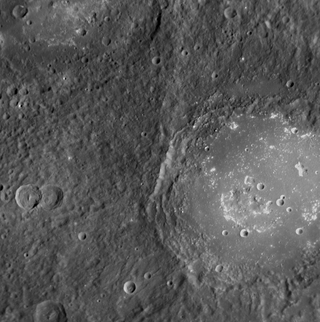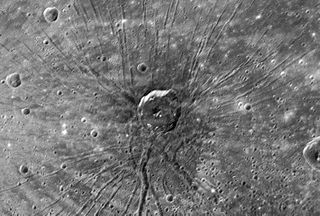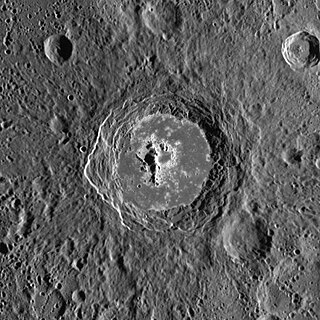
Yeats is an impact crater on the planet Mercury. The crater is named after William Butler Yeats, an Irish poet and dramatist. The name was adopted by the International Astronomical Union in 1976.

Lermontov is an impact crater on the planet Mercury. The crater is named after Mikhail Yuryevich Lermontov, a 19th-century Russian poet. The name was approved by the International Astronomical Union in 1976.

Sholem Aleichem is a crater on Mercury, named after the Yiddish writer Sholem Aleichem. The inter-crater plain deposits have been deformed by linear ridges.

Eminescu is a peak ring crater on Mercury 125 kilometers (78 mi) in diameter. Since there are very few later craters superposed on it, Eminescu appears to be a young crater formed around one billion years ago. It has a transitional morphology between larger more complex impact basins like Raditladi and smaller simpler central peak craters.

Apollodorus is an impact crater on Mercury. Its unusual appearance, with radiating dark troughs, led to a nickname of "the Spider" by scientists before its official name was decided. Apollodorus is located near the center of Pantheon Fossae, which is a system of radial grabens situated in the inner part of the Caloris basin. The floor, rim and walls of Apollodorus expose a low reflectance material (LRM) excavated during the impact from beneath the light volcanic plains, which cover the central part of the Caloris.

Located in the western edge of Mercury's giant Caloris basin, Kertész crater has some unusual, bright material located on its floor. Sander crater, located in the northwestern edge of Caloris basin, also shows bright material on its floor. Just northeast of Kertész a small crater has very bright rays and ejecta, indicating that the crater is young.

Atget crater is distinctive on the planet Mercury's surface due to its dark color. Atget crater is located within Caloris basin, near Apollodorus crater and Pantheon Fossae. The dark color of the floor of Atget is in contrast to other craters within Caloris basin that exhibit bright materials on their floors, such as the craters Kertész and Sander. Other craters on Mercury, such as Bashō and Neruda, have halos of dark material but the dark material does not cover the crater floors.

Sander is a crater on Mercury within Caloris Basin. It has dark walls and bright patches on its floor. Unlike the rays of Bashō crater, the bright areas are not believed to be immature, but they are inherently bright. It is named after the German photographer August Sander (1876–1964).

Praxiteles is a crater on Mercury. It is one of 110 peak ring basins on Mercury.

Amaral is a crater on the planet Mercury. With its smooth floor, surrounding ejecta, and small secondary craters, it appears noticeably younger than the heavily cratered surface around it. Along with a smooth crater floor, Amaral also has a central peak. Bright material on this peak is of particular interest as it appears to have an unusual color. In color-enhanced images, the central peak of Amaral appears as a bright blue color in striking contrast to the otherwise orange tones of surface material nearby. The different color of the central peak likely indicates rocks with different chemical composition from those on the neighboring surface.

Bartók is a crater on Mercury. Its name was adopted by the International Astronomical Union (IAU) in 1979. Bartók is named for the Hungarian composer Béla Bartók, who lived from 1881 to 1945.

Chaikovskij is a crater on Mercury. It has a diameter of 171 kilometers. Its name was adopted by the International Astronomical Union (IAU) in 1976. Chaikovskij is named for the Russian composer Pyotr Ilyich Tchaikovsky, who lived from 1840 to 1893.

Darío is a crater on Mercury. It has a diameter of 151 kilometers. Its name was adopted by the International Astronomical Union (IAU) in 1976. Dario is named for the Nicaraguan poet Rubén Darío, who lived from 1867 to 1916.

Equiano is a crater on Mercury. It has a diameter of 102 kilometers. Its name was adopted by the International Astronomical Union in 1976. Equiano is named for the abolitionist writer Olaudah Equiano, who lived from 1750 to 1797.

Geddes is a crater on Mercury. It has a diameter of 84 kilometers. Its name was adopted by the International Astronomical Union (IAU) in 2010. Geddes is named for the Irish stained glass artist Wilhelmina Geddes, who lived from 1887 to 1955.

Hitomaro is a crater on Mercury. It has a diameter of 105 kilometers. Its name was adopted by the International Astronomical Union (IAU) in 1976. Hitomaro is named for the Japanese poet Kakinomoto no Hitomaro, who lived from the 650s to roughly 709.

Judah Ha-Levi is a crater on Mercury. Its name was adopted by the International Astronomical Union (IAU) in 1976. Judah Ha-Levi is named for the Spanish-Jewish poet and philosopher Judah Ha-Levi, who lived from 1075 to 1141.

Warhol is a crater on Mercury. Its name was adopted by the IAU in 2012, after the American artist Andy Warhol.
Hollows are a landform on the planet Mercury, discovered during the MESSENGER mission that orbited the planet from 2011 to 2015.

Baranauskas is a crater on Mercury. It has a diameter of 36 kilometres. Its name was adopted by the International Astronomical Union (IAU) on September 25, 2015. Baranauskas is named for the Lithuanian poet Antanas Baranauskas.























